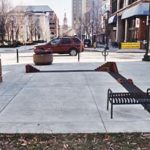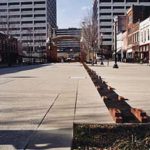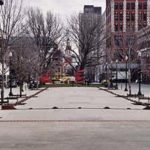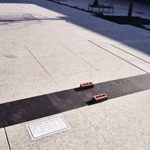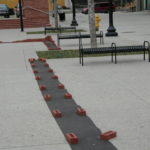Footprint.
The area used by a building structure, defined by the perimeter of the building plan.
An area or subject occupied or affected by something.
A building footprint, of a very specific building but of universal American character.

This 1866 drawn map shows the center of the busy town of Knoxville, Tennessee. There is the very linear Market House, in the exact middle. It had several iterations, the most recent one built in 1901. It was razed in 1960 and not replaced. An open plaza is all most of us have known in the center of town.
The Market House presence is invisible, but affecting. There is an etheric and emotional footprint I felt drawn to re-enact somehow.
The large open space that remains is lovely, but what if we had a sense of that huge central building with its massive presence and we were able to imagine the bustling life and connections among Knoxville’s earlier generations?

I delineate, with tarpaper and bricks, the footprint of this building. Texts gleaned from my research on its history is posted in key locations, for reflection on this place as a center of public, economic, and social life — and as a meditation on the impermanence of all things.
Review:
The installation took about 10 hours and in itself became a performance of sorts. Children (who do what adults wish to do) ran and played along the “inside” and “outside” footprint boundaries, climbed on bricks, rearranging the taller towers, leaving white footprints of dust on the black tarpaper, and in demonstrating their delight, allowed adults to approach me too as I worked, with the question, “I’m sorry, you’ve probably been asked this a million times, but what are you doing?”

Older folks who remembered the building before it came down loved telling their memories of life in the 1950s on Market Square. I wish I’d foreseen that Part Two of this temporary installation could have been oral history interviews!
